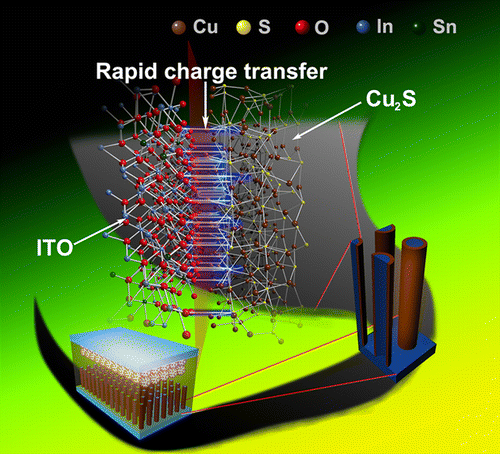Yan Jiang, Xing Zhang, Qian-Qing Ge, Bin-Bin Yu,Yu-Gang Zou, Wen-Jie Jiang, Jin-Song Hu*, Wei-Guo Song*, and Li-Jun Wan
ACS Appl. Mater. Interfaces, 2014, 6 (17), pp 15448–15455, DOI: 10.1021/am504057y
http://pubs.acs.org/doi/abs/10.1021/am504057y
Abstract (click image for pdf file)

Among the issues that restrict the power conversion efficiency (PCE) of quantum-dot-sensitized solar cells (QDSSCs), insufficient catalytic activity and stability of counter electrodes (CEs) are critical but challenging ones. The state-of-the-art Cu/Cu2S CEs still suffer from mechanical instability and uncertainty due to the reaction of copper and electrolyte. Herein, ITO@Cu2S core–shell nanowire arrays were developed to fabricate CEs for QDSSCs, which have no such issues in Cu/Cu2S CEs. These nanowire arrays exhibited small charge transfer resistance and sheet resistance, and provided more active catalytic sites and easy accessibility for electrolyte due to the three-dimensional structure upon use as CEs. More interestingly, it was found that the interface of ITO/Cu2S significantly affected the performance of ITO@Cu2S nanowire array CEs. By varying synthetic methods, a series of ITO@Cu2S nanowire arrays were prepared to investigate the influence of ITO/Cu2S interface on their performance. The results showed that ITO@Cu2S nanowire array CEs with a continuous Cu2S nanocrystal shell fabricated via an improved cation exchange route exhibited excellent and thickness-dependent performance. The PCE of corresponding QDSSCs increased by 11.6 and 16.5% compared to that with the discrete Cu2S nanocrystal and the classic Cu/Cu2S CE, respectively, indicating its promising potential as a new type of CE for QDSSCs.

